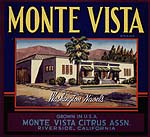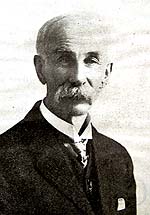
Historical Scrapbook:
RIVERSIDE LIBRARIES 1873-1903
The Carnegie Building 1903-1964

Lyman Evans.
A member of the Library Board of Trustees and District Attorney. The initiative lead by him and by his wife Mary secured the grant for the Riverside Carnegie Library.
Photo courtesy of Riverside Public Library.
View of the Reading Room
in the Carnegie Library. The Reading Room was added to the building in 1909 using another $15,000 Carnegie Grant. Expansion of the building also enabled creation of a separate children's room.
Photo courtesy of Riverside Public Library.
A table and few chairs from the Carnegie Library are still in use in the local history section of the Riverside Public Library.
Photo Vlasta Radan, 2006.
Two stained glass candelabra that flanked the entrance of the Carnegie Library are now at the entrance of the Main Library building.
Photo Vlasta Radan, 2006.
After the 1900s, the Riverside Public Library desperately needed a bigger space, preferably its own building, but the City could not come up with the money for such a project. So, as many other communities in Great Britain and the United Sates, Riverside and in particular its Woman’s Club that was organizing the drive for the new library building, placed their hopes in Andrew Carnegie and his philanthropy.
During the second half of the 19th century, Andrew Carnegie rose from humble origins in Scotland to become one of the most powerful American industrialists, and one of the wealthiest men of his era. Although he did not become rich by being overly sensitive for the social plight of the workers working in his steel factories, he did take to heart the Calvinist idea that abundant wealth carried with it duties toward the wider society. He established a series of charitable foundations, which then financed various cultural and educational institutions in Great Britain and the United States. In the United States, in the period between 1886-1919, he provided grants for the construction of 1,689 library buildings across the continent. In California alone, 142 libraries were built using these grants (Jones 1997, p. 128). Although Carnegie was responsible for the final decisions, most of the correspondence related to these library grants was carried on by his personal secretary James Bertram.
The initial exchange between Riverside Women’s Club and James Bertram was not too promising. Mary Evans, a member of the Club, approached her husband Lyman Evans, District Attorney and secretary of the Library Board of Trustees, to help in the matter. He took over the correspondence with Bertram, eventually convincing him that Riverside deserves the grant. Evans also used his political skills to bring the City Board of Trustees to agree on the financial requirements attached to the grant. Carnegie insisted that cities desiring the grants accept the obligations for the future upkeep of the library, usually in an amount equal to 10% of the value of the grant. Riverside received the $20.000 grant, what was less than the City thought it should be, but Bertram begged to differ. The City needed to come up with its own funds for land and furniture in the building. The library’s Local History collection still has some of the original documents associated with the call for the architectural design, offers for the library grounds as well as some of the Carnegie correspondence.
The building project was plagued with financial difficulties, budget shortfalls, and trustee resignations. Finally, on July 31, 1903, the new building was opened with all the appropriate pomp and celebration. The building was designed by a firm from Los Angeles in “Mission Revival” style, characteristic of most of downtown Riverside. The main floor of the library was divided by colonnades into a reference area, stacks, and library offices. The space in the basement was reserved for book cataloging. The library were decorated by S. S. Nicolini, who also painted the pictures of the muses on the panels in the reading room. Unfortunately, in 1965 this beautiful building was torn down and replaced with a soulless modernistic cube.
The librarian of the grand new library was Grace L. Mansfield, who started as library assistant to Mary M. Smith. Mansfield served as City librarian until 1905, when she give her resignation over the dispute with the Library Board about salaries. The payment of the librarians was quite small and did not change much over the decades. In June of 1894, Mary M. Smith received $50, and Grace L. Mansfield $10, in lieu of monthly salaries. In 1903, Grace L. Mansfield, now the head librarian, received $60, and Margaret Kyle, assistant librarian, $54. In 1905, the Library Board decided to raise the salaries of Mansfield to $65 and that of Kyle to $55 for a 42-hour workweek. Mansfield was of the opinion that the difference between salaries among the library positions should be bigger and that the head librarian should receive a higher salary anyway.
After the resignation of Mansfield, Margaret Kyle become the City Librarian. During her tenure, the library continued to grow, adding to its collections audio-visual materials (stereopticons) and opening its first branch in Arlington. In 1908, the library added a west wing to the original building. That expansion enabled the creation of a special children’s room and services; a separate common room and toilets for staff; and additional shelving space for the government documents and the budding agriculture collection.
In 1901, the Board of Directors revised the Rules and Regulation so that the library was to be open every day from 9 to 9, on Sundays 1 pm to 5 pm, including holidays. The library was closed only for July 4th and December 25th. Borrowing privileges were extended to all citizens of Riverside, residents or not, who pay taxes inside the city limits. The children eight years and older could borrow books. In general, a cardholder could borrow only one book; however, the holders of the “non-fiction cards” could take extra books or library material for the purpose of study. For the first time the library was also offering to keep books on hold and send the notice to the patrons when they became available. The library had devised the system that allowed temporary residents (mostly Mission Inn guests) to obtain extended borrowing privileges or just borrow a book for day or two, usually paying 2 cents a day for the privilege.
In 1910, Margaret Kyle came into the cross-hairs at the Library Board and resigned her position. Her resignation was a turning point in development of the Riverside Public Library–for the next 65 years she was the last female to manage the library. In 1910, the Library Board hired for the position of the City librarian Joseph F. Daniels, an experienced librarian working in the Colorado State Normal School. There he organized librarianship courses and was actively involved in development of the theoretical foundations of American librarianship. His tenure (1910-1921) was quite controversial, but he organized the Riverside Public Library Service School (1912-1943) and build the Riverside Public Library from small provincial library into a library with one of the largest book collection in Southern California, with the “most sophisticated reference service, and best trained library staff outside of Los Angeles” (Baker 1988, p. 20).
More information about CARNEGIE LIBRARIES OF CALIFORNIA
is on the web site created by
Lucy Kortum, Pat & Bernie Skehan,
Dr. George Bobinski and Dr. Abigail Van Slyck
Text, design, and digital imaging by Vlasta Radan.
Last update May 4, 2006.





